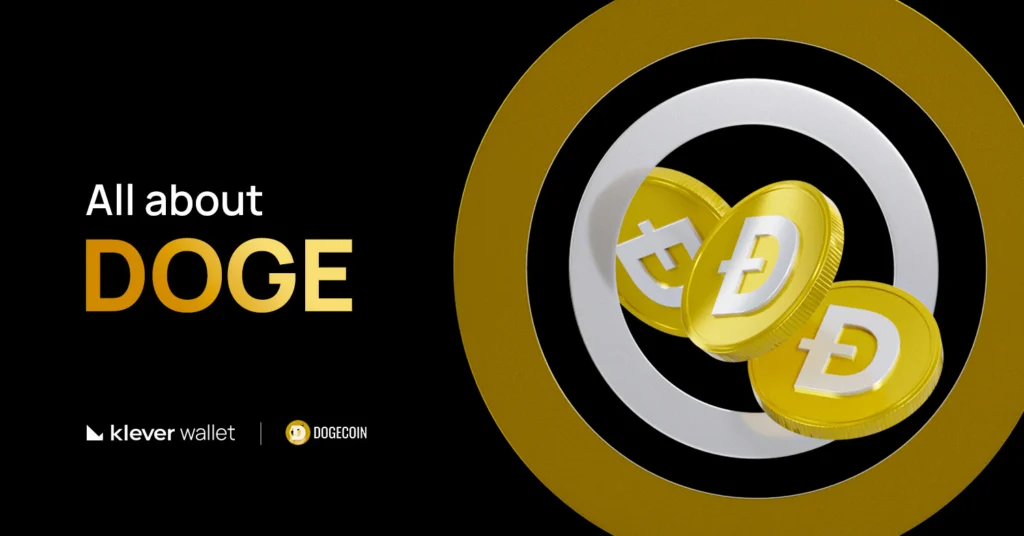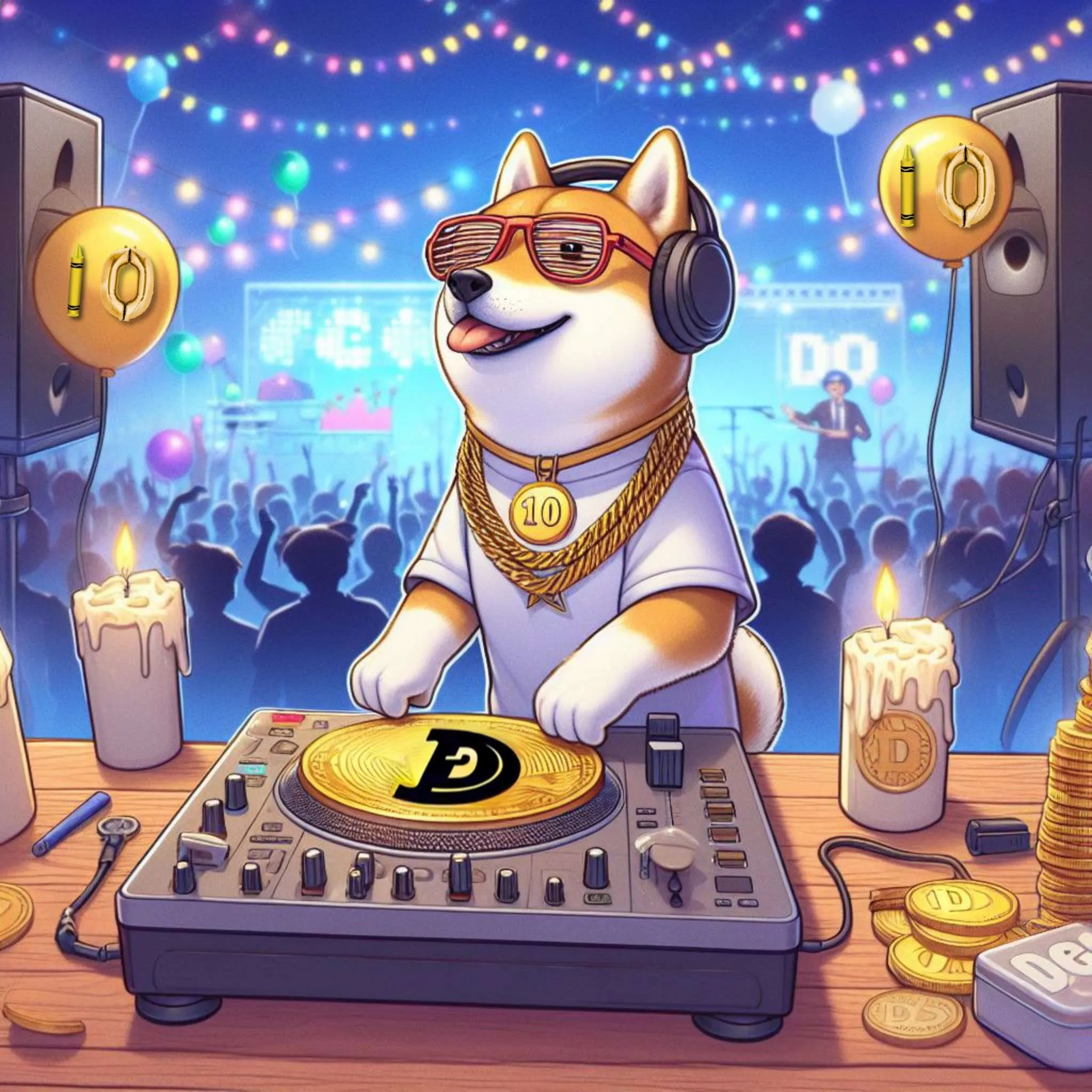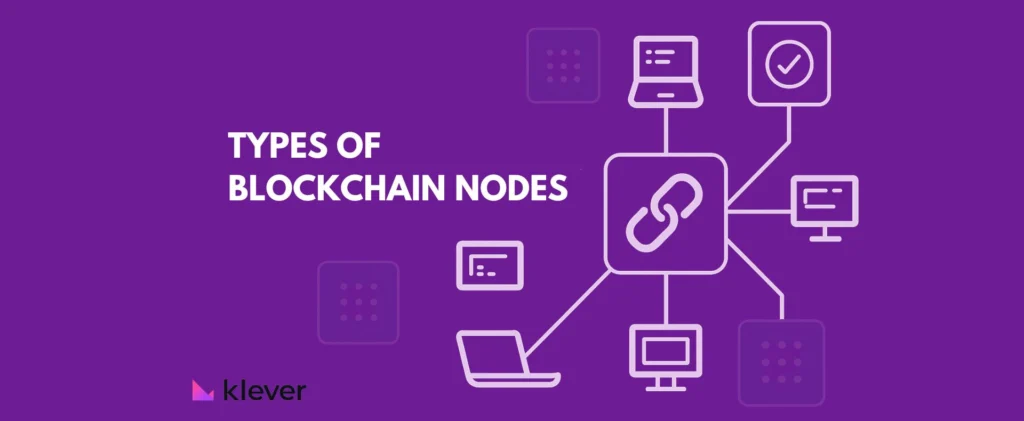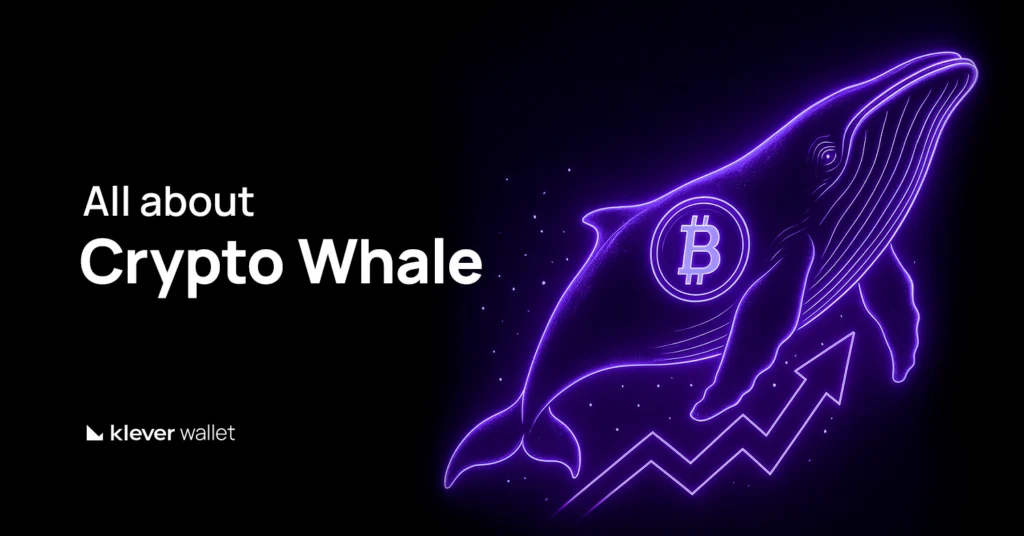
Key Information about DOGE
| Information | Details |
| Ticker | DOGE |
| Category | Peer-to-peer cryptocurrency (meme coin; payment token) |
| Founder(s) | Billy Markus and Jackson Palmer |
| Blockchain | Dogecoin (fork of Litecoin, Scrypt algorithm) |
| Max TPS | ~30–40 transactions per second (theoretical) |
| Consensus Mechanism | Proof-of-Work (Scrypt) — merge-mined with Litecoin via AuxPoW |
| Launch Date | December 6, 2013 |
| Maximum Supply | Unlimited (fixed issuance: 10,000 DOGE/block ≈ 5.26 billion/year) |
| Blockchain Explorer | dogechain.info / blockchair.com/dogecoin |
What Is DOGE?

Dogecoin (DOGE) is a peer-to-peer cryptocurrency created in 2013 as a fork — meaning a copy of Litecoin’s code — with a focus on fast and affordable transactions.
It is considered an altcoin and stands out as a unique cryptocurrency that started as a humorous project in 2013 but quickly gained popularity, becoming a major player in the crypto market. Unlike Bitcoin, Dogecoin offers a more lighthearted approach, inspired by the viral “Doge” meme featuring the Shiba Inu dog.
Unlike Bitcoin, it doesn´t have a maximum supply cap. Its main difference lies in its inflationary model: for every block mined (about every 1 minute), 10,000 DOGE are issued, totaling around 5.26 billion new coins per year. This ensures continuous liquidity but requires increasing demand to maintain its price.
Why Was DOGE Created?
Dogecoin was born as a fun alternative to Bitcoin, inspired by the Shiba Inu meme. The original idea was to make cryptocurrency use more approachable and accessible, mainly for micropayments and online tipping.
Over the years, it has grown into one of the largest digital currencies by market value, supported by an active community and high-profile backers.
How Does DOGE Work?
- Consensus Mechanism: Proof-of-Work using the Scrypt algorithm — simpler and more energy-efficient for mining.
- Merge-Mining: Since 2014, DOGE has been mined alongside Litecoin (LTC) via the AuxPoW system, which strengthens its security.
- Blocks: ~1 minute each, with a fixed reward of 10,000 DOGE.
- Inflation: Constant in absolute numbers, but with a decreasing percentage rate over time.
- Official Software: Dogecoin Core 1.14.9 — keeps the Dogecoin network running (latest stable version, including bug fixes and stronger robustness).
Merged Mining with Litecoin
Since 2014, Dogecoin has been mined together with Litecoin through a system called merged mining.
In practice, it works like this:
- When a miner mines Litecoin, they can simultaneously validate Dogecoin blocks.
- This does not require extra work from the computer — it’s essentially earning two coins for the price of one.
Before this change, Dogecoin had fewer miners and was more vulnerable to attacks. With merged mining, it began leveraging Litecoin’s network power, making an attack on Dogecoin as costly and difficult as attacking Litecoin itself.
Recent DOGE Core Updates
Dogecoin runs on a program called Dogecoin Core, the main software used by network nodes to validate transactions and blocks. It functions as the “heart” of the blockchain.
In 2024, this software received three important updates: 1.14.7, 1.14.8, and 1.14.9. These updates introduced:
- Bug fixes: Adjustments to minor issues to ensure smooth network operation.
- Security improvements: Reinforcements against potential vulnerabilities, protecting users and miners.
- Performance enhancements: Optimizations for faster and more efficient transaction processing.
Why Does This Matter?
Keeping Dogecoin Core updated is essential because it:
- Ensures the network remains secure against attacks.
- Improves system stability.
- Shows that the project remains active and maintained by developers — unlike abandoned coins.
Real-World Use Cases of Dogecoin in 2025
-
Payments in Companies
Dogecoin is already accepted as a payment method by major brands:
- Tesla: allows customers to buy merchandise directly with DOGE.
- AMC Theatres: movie tickets and products can be purchased via BitPay integration.
- Marketplaces via gift cards: platforms like BitPay enable the use of DOGE for gift cards from popular stores such as Newegg and PlayStation Store.
-
Digital Tipping and Microtransactions
DOGE remains popular across forums, live streams, and social networks for digital tipping — a fast and inexpensive way to support content creators and online communities.
-
E-commerce and Tourism
Payment gateways such as BitPay and NOWPayments list hundreds of online merchants and travel services that accept DOGE, either directly or through intermediaries. This extends its use to bookings, accommodations, and everyday shopping.
-
Experimental Tokens on Dogecoin
Beyond payments, the community has been exploring ways to expand the ecosystem:
- DRC-20: a standard inspired by ERC-20 tokens, adapted for Dogecoin.
- Doginals: a mechanism that allows inscribing data and creating digital assets on the Dogecoin blockchain, similar to Bitcoin’s Ordinals.
These experiments are still early-stage and high-risk but demonstrate that Dogecoin is evolving beyond being just a transactional currency.
What Determines the Price of DOGE?
- Supply and predictable issuance – 5.26 billion DOGE are created each year.
- Liquidity and correlation with BTC/altcoins – its price follows broader crypto market cycles.
- Commercial adoption – large companies increase its real-world utility.
- Influence of public figures – tweets and announcements from Elon Musk still trigger sharp price swings.
- Political and legal news – indirect mentions (such as the “DOGE Department” in the U.S.) and legal decisions involving Tesla and Musk affect perception.
- Global regulatory environment – changes in usage rules and compliance impact institutional demand.
Is Dogecoin Safe in 2025?
Advantages:
- Proof-of-Work plus merged mining with Litecoin provides strong protection against attacks.
- Updated software with fixes inherited from Bitcoin.
- Regular Dogecoin Core updates strengthen the stability of the protocol.
Risks:
- Extreme volatility, typical of assets with strong “meme” appeal.
- Constant monetary inflation can dilute long-term investors.
- Security relies on the continued participation of Litecoin miners.
- Scams and phishing (fake websites impersonating Dogecoin or Dogechain).
- Third-party bridges and dApps (higher risk than the native blockchain).
- Centralized custody (unreliable exchanges and apps).
For payments and fast transfers, DOGE is safe and functional. As an investment, however, it requires risk management due to its highly volatile price.
DOGE Tokenomics
1. Overview
- Token Symbol: DOGE
- Blockchain: Native to its own blockchain (a proof-of-work network derived originally from Litecoin).
- Utility: Used for tipping, small transactions, micropayments, community rewards; also traded/speculated like other cryptos. It has become part of culture & social media.
2. Allocation and Supply
- Total Supply: There is no maximum cap on how many DOGE can exist.
- Circulating Supply: Around 150.9-151 billion DOGE are in circulation.
- Supply Allocation: All DOGE comes from mining (proof-of-work). Block rewards are issued continuously; about 5 billion DOGE are added every year permanently. There are no reserved allocations or scheduled burns.
3. Utility and Rewards
- In-Blockchain Use: DOGE is used to pay for transactions and transfers on its own network; it does not support smart contracts natively. It’s more about peer-to-peer payments, tips, and community transfers.
- Staking: No native staking mechanism—since it’s proof-of-work.
- Governance: No formal on-chain governance structure. Development and network parameters are influenced by the community and maintainers, but DOGE holders don’t vote via protocol-level governance like some other chains.
4. Economic Model
- Deflationary Mechanisms: None. Because supply is unlimited and new DOGE are always being minted (block rewards), the model is inflationary.
- Reward Distribution: Miners who do proof-of-work get block rewards. There are no staking or yield rewards built into the system. All new DOGE issuance goes to miners.
Market Performance (dados mais recentes)
- Preço Atual: ~US$ 0.264 (faixa entre US$ 0.2639 e US$ 0.270)
- Market Cap: Aproximadamente US$ 39.8 – 40.7 bilhões
- Circulating Supply: Cerca de 150.98 bilhões de DOGE em circulação
- Volume de 24h: Entre US$ 3.25 – 4.4 bilhões
- All-Time High (ATH): ~US$ 0.73 em maio de 2021
- All-Time Low (ATL): ~US$ 0.0000869 em 2015
Store DOGE Securely with Klever Wallet
Dogecoin has proven to be much more than a joke: today, it’s a functional network with real adoption and a unique cultural narrative.
In 2025, its technical security is backed by merge-mining with Litecoin, but investing in DOGE remains risky due to its volatility.
With Klever Wallet, you can safely store, send, and use DOGE with full self-custody — without sacrificing simplicity. It’s a secure, multi-chain wallet built for those who truly value financial freedom.
Download Klever Wallet today and keep the power of DOGE in your hands with safety and convenience.
Dogecoin FAQ
1. What is Dogecoin used for in 2025?
Dogecoin (DOGE) is mainly used for tipping creators, micropayments, and online purchases when accepted by merchants. Many people also buy and hold DOGE as an investment, while others use it for transfers thanks to its fast and low-cost transactions.
2. Does Dogecoin have unlimited supply?
Yes. Unlike Bitcoin, Dogecoin has no maximum supply. Around 5.26 billion new DOGE are issued every year through mining. This inflationary model ensures continuous liquidity, but it means long-term value depends heavily on growing adoption and demand.
3. How can I buy Dogecoin safely and with low fees?
To buy DOGE, most users choose crypto exchanges like Binance, Coinbase, or Kraken. To save on fees:
- Compare deposit and withdrawal costs across platforms.
- Use bank transfers or stablecoins to reduce trading fees.
- Move DOGE to a secure wallet after purchase to avoid leaving funds on exchanges.
4. Should I keep my Dogecoin on an exchange or in a wallet?
- Exchanges: convenient for quick trades, but riskier since you don’t control your private keys.
- Wallets: more secure and recommended for long-term storage. Options include Klever Wallet, Ledger, or Trezor, which give you full self-custody.
5. What factors determine the price of Dogecoin?
The main Dogecoin price drivers include:
- Market sentiment and social media hype (especially posts from Elon Musk).
- Crypto market cycles, as DOGE often follows Bitcoin and altcoins.
- Merchant adoption for payments.
- Regulatory news and legal decisions.
- Technical updates (such as Dogecoin Core improvements).
6. Is Dogecoin safe in 2025?
Dogecoin is considered safe for payments and transfers, thanks to its Proof-of-Work mechanism and merged mining with Litecoin, which strengthens security. However, as an investment it carries risks:
- High volatility.
- Constant monetary inflation.
- Scams, phishing sites, and unreliable apps.
For security, always use a trusted wallet and avoid shady third-party platforms.
7. Can Dogecoin reach $1 or more?
This is one of the most asked questions about Dogecoin. In theory, DOGE can reach $1 if demand grows faster than its yearly issuance and adoption expands globally. However, the unlimited supply model makes it harder compared to capped assets like Bitcoin. While some analysts believe $1 is possible in the long term, others see it as unlikely without major adoption by merchants and institutions.




